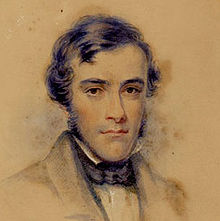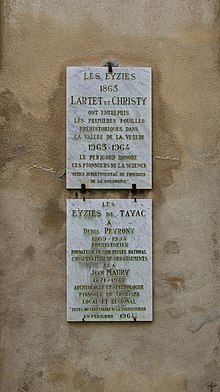Henry Christy: Difference between revisions
→Early life: ref for APS |
→Legacy: Steinhauer catalogue |
||
| Line 52: | Line 52: | ||
In April 1865 Christy left England with a small party of geologists to examine some caves which had recently been discovered in Belgium, near [[Dinant]]. While at work he caught a severe cold. A subsequent journey with M. and Mme. Lartet to [[La Palisse]] brought on inflammation of the lungs, of which he died on 4 May 1865.<ref name=DNB/> |
In April 1865 Christy left England with a small party of geologists to examine some caves which had recently been discovered in Belgium, near [[Dinant]]. While at work he caught a severe cold. A subsequent journey with M. and Mme. Lartet to [[La Palisse]] brought on inflammation of the lungs, of which he died on 4 May 1865.<ref name=DNB/> |
||
==Collections and legacy== |
|||
==Legacy== |
|||
By his will Christy bequeathed his collections of modern objects to the nation; his archaeological collection went to the nation, but with the finds from excavations in France to be shared with the French [[Musée d'Archéologie Nationale]], which was to get the most important pieces.<ref>[http://www.britishmuseum.org/research/search_the_collection_database/search_object_details.aspx?objectId=1502912 Acquisition note], British Museum</ref> He also left £5000 which established the Christy fund that allowed the British Museum to purchase many more artefacts;<ref name="bm">[http://www.britishmuseum.org/research/search_the_collection_database/term_details.aspx Christy Fund], British Museum, accessed August 2010</ref> with a sum of money to be applied to curationc and public exhibition. As there was then no spare room at the British Museum, the trustees secured the suite of rooms at 118 Victoria Street, Westminster (in which Christy himself had lived) and here the collection was exhibited, under the care of [[A. W. Franks]], until 1884. In that year the removal of the natural history department to South Kensington made room for the collection at the British Museum.<ref name="bm"/> <ref name=DNB/> |
By his will Christy bequeathed his collections of modern objects to the nation; his archaeological collection went to the nation, but with the finds from excavations in France to be shared with the French [[Musée d'Archéologie Nationale]], which was to get the most important pieces.<ref>[http://www.britishmuseum.org/research/search_the_collection_database/search_object_details.aspx?objectId=1502912 Acquisition note], British Museum</ref> He also left £5000 which established the Christy fund that allowed the British Museum to purchase many more artefacts;<ref name="bm">[http://www.britishmuseum.org/research/search_the_collection_database/term_details.aspx Christy Fund], British Museum, accessed August 2010</ref> with a sum of money to be applied to curationc and public exhibition. As there was then no spare room at the British Museum, the trustees secured the suite of rooms at 118 Victoria Street, Westminster (in which Christy himself had lived) and here the collection was exhibited, under the care of [[A. W. Franks]], until 1884. In that year the removal of the natural history department to South Kensington made room for the collection at the British Museum.<ref name="bm"/> <ref name=DNB/> |
||
In 1864 he wrote an account of the work which was being carried out at his expense in the Vézère Valley; these notices appeared in the ''[[Comptes rendus]]'' (29 February 1864) and ''[[Ethnological Society of London|Transactions of the Ethnological Society of London]]'' (21 June 1864). They referred mainly to the "reindeer period", as the time of the cavemen in southern France then came to be styled. Christy's funding contributed to the discovery of [[Cro-Magnon]] man in 1868 in a cave near [[Les Eyzies]]. An account of the explorations appeared in Christy left a half-finished book, entitled ''Reliquiae Aquilanicae, being contributions to the Archaeology and Paleontology of Perigord and the adjacent provinces of Southern France''; this was completed by Christy's executors, first by Lartet and, after his death in 1870, by [[Rupert Jones]].<ref name=ency>{{cite EB1911}}</ref><ref name=DNB/> |
Christy had a partial catalogue of his collections made in 1862, by [[Carl Ludvig Steinhauer]].<ref>[http://www.britishmuseum.org/research/search_the_collection_database/term_details.aspx?bioId=40853 British Museum, biography of Christy.]</ref> In 1864 he wrote an account of the work which was being carried out at his expense in the Vézère Valley; these notices appeared in the ''[[Comptes rendus]]'' (29 February 1864) and ''[[Ethnological Society of London|Transactions of the Ethnological Society of London]]'' (21 June 1864). They referred mainly to the "reindeer period", as the time of the cavemen in southern France then came to be styled. Christy's funding contributed to the discovery of [[Cro-Magnon]] man in 1868 in a cave near [[Les Eyzies]]. An account of the explorations appeared in Christy left a half-finished book, entitled ''Reliquiae Aquilanicae, being contributions to the Archaeology and Paleontology of Perigord and the adjacent provinces of Southern France''; this was completed by Christy's executors, first by Lartet and, after his death in 1870, by [[Rupert Jones]].<ref name=ency>{{cite EB1911}}</ref><ref name=DNB/> |
||
==References== |
==References== |
||
Revision as of 08:14, 7 February 2012
Henry Christy | |
|---|---|
 | |
| Born | 1810 |
| Died | 1865 |
| Cause of death | inflammation of the lungs |
| Nationality | United Kingdom |
Henry Christy (26 July 1810 – 4 May 1865) was an English banker and collector who left his substantial collections to the British Museum.
Early life
Christy was born at Kingston upon Thames, the second son of William Miller Christy of Woodbines, a Quaker banker who started out in hat manufacture with interests in Stockport, before becoming a financier.[1] Trained to business by his father, Henry became a partner in the house of Christy & Co. in Gracechurch Street, and succeeded his father as a director of the London Joint-Stock Bank.[2]
Christy was a philanthropist, active in the Great Famine and other causes.[3] He was one of the founders of the Aborigines' Protection Society.[4] He belonged to both the Ethnological Society of London and the Anthropological Society of London, representing different strands of learned interest arising from early ethnology.[5]
Collector
In 1850 Christy began to visit foreign countries. Among the fruits of his first expedition to the East were an extensive collection of Eastern fabrics, and a large series of figures from Cyprus, which are now in the British Museum. After the Great Exhibition of 1851, Christy began the study of tribal peoples. In 1852, and again in 1853, he travelled in Denmark, Sweden, and Norway. The public collections of antiquities at Stockholm and Copenhagen were a revelation to him, and from this time he collected objects from contemporary and prehistoric periods. The year 1856 was devoted to America. Travelling over Canada, the United States, and British Columbia, Christy met Edward Burnett Tylor in Cuba, and they went on together to Mexico, where Christy made many purchases. Their Mexican travels were described by Tylor in his Anahuac (London, 1861).[2]

In 1858 the antiquity of man was proved by the discoveries of Boucher de Perthes on flint implements in France; Christy joined the Geological Society that year. He went with the French palæontologist Edouard Lartet in the examination of the caves along the valley of the Vézère, a tributary of the Dordogne River, in the south of France. Remains are embedded in the stalagmites of these caves. Thousands of specimens were obtained, some of them being added to Christy's collection.[2] The sites they investigated included Le Moustier, the Abri de la Madeleine, both important type sites.
Death
In April 1865 Christy left England with a small party of geologists to examine some caves which had recently been discovered in Belgium, near Dinant. While at work he caught a severe cold. A subsequent journey with M. and Mme. Lartet to La Palisse brought on inflammation of the lungs, of which he died on 4 May 1865.[2]
Collections and legacy
By his will Christy bequeathed his collections of modern objects to the nation; his archaeological collection went to the nation, but with the finds from excavations in France to be shared with the French Musée d'Archéologie Nationale, which was to get the most important pieces.[6] He also left £5000 which established the Christy fund that allowed the British Museum to purchase many more artefacts;[7] with a sum of money to be applied to curationc and public exhibition. As there was then no spare room at the British Museum, the trustees secured the suite of rooms at 118 Victoria Street, Westminster (in which Christy himself had lived) and here the collection was exhibited, under the care of A. W. Franks, until 1884. In that year the removal of the natural history department to South Kensington made room for the collection at the British Museum.[7] [2]
Christy had a partial catalogue of his collections made in 1862, by Carl Ludvig Steinhauer.[8] In 1864 he wrote an account of the work which was being carried out at his expense in the Vézère Valley; these notices appeared in the Comptes rendus (29 February 1864) and Transactions of the Ethnological Society of London (21 June 1864). They referred mainly to the "reindeer period", as the time of the cavemen in southern France then came to be styled. Christy's funding contributed to the discovery of Cro-Magnon man in 1868 in a cave near Les Eyzies. An account of the explorations appeared in Christy left a half-finished book, entitled Reliquiae Aquilanicae, being contributions to the Archaeology and Paleontology of Perigord and the adjacent provinces of Southern France; this was completed by Christy's executors, first by Lartet and, after his death in 1870, by Rupert Jones.[9][2]
References
- ^ Humphrey Lloyd. The Quaker Lloyds in the Industrial Revolution 1660-1860 (2006), p. 285; Google Books.
- ^ a b c d e f Dictionary of National Biography, Christy, Henry (1810–1865), ethnologist, by W. J. Harrison. Published 1887.
- ^ Helen Elizabeth Hatton, The Largest Amount of Good: Quaker Relief in Ireland, 1654-1921 (1993), pp. 178–9;Google Books.
- ^ Richard King, Obituary of Thomas Hodgkin, M.D., Transactions of the Ethnological Society of London , Vol. 5, (1867), pp. 341-345. Published by: Royal Anthropological Institute of Great Britain and Ireland. Article Stable URL: http://www.jstor.org/stable/3014240
- ^ George W. Stocking, Jr., What's in a Name? The Origins of the Royal Anthropological Institute (1837-71), Man, New Series, Vol. 6, No. 3 (Sep., 1971), pp. 369-390; Published by: Royal Anthropological Institute of Great Britain and Ireland. Stable URL: http://www.jstor.org/stable/2799027; PDF, at p. 372.
- ^ Acquisition note, British Museum
- ^ a b Christy Fund, British Museum, accessed August 2010
- ^ British Museum, biography of Christy.
- ^ Chisholm, Hugh, ed. (1911). Encyclopædia Britannica (11th ed.). Cambridge University Press.
{{cite encyclopedia}}: Missing or empty|title=(help)
- Attribution
![]() This article incorporates text from a publication now in the public domain: Dictionary of National Biography. London: Smith, Elder & Co. 1885–1900.
This article incorporates text from a publication now in the public domain: Dictionary of National Biography. London: Smith, Elder & Co. 1885–1900. {{cite encyclopedia}}: Missing or empty |title= (help)
